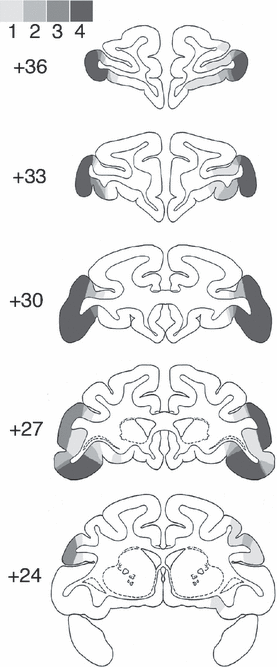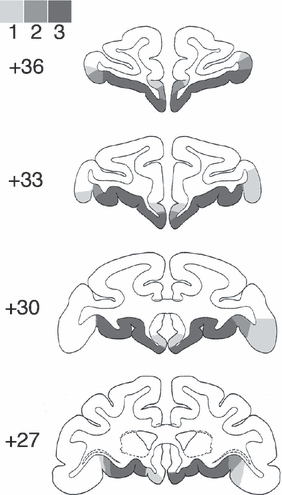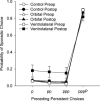Ventrolateral prefrontal cortex is required for performance of a strategy implementation task but not reinforcer devaluation effects in rhesus monkeys
- PMID: 19453635
- PMCID: PMC2688497
- DOI: 10.1111/j.1460-9568.2009.06740.x
Ventrolateral prefrontal cortex is required for performance of a strategy implementation task but not reinforcer devaluation effects in rhesus monkeys
Abstract
The ability to apply behavioral strategies to obtain rewards efficiently and make choices based on changes in the value of rewards is fundamental to the adaptive control of behavior. The extent to which different regions of the prefrontal cortex are required for specific kinds of decisions is not well understood. We tested rhesus monkeys with bilateral ablations of the ventrolateral prefrontal cortex on tasks that required the use of behavioral strategies to optimize the rate with which rewards were accumulated, or to modify choice behavior in response to changes in the value of particular rewards. Monkeys with ventrolateral prefrontal lesions were impaired in performing the strategy-based task, but not on value-based decision-making. In contrast, orbital prefrontal ablations produced the opposite impairments in the same tasks. These findings support the conclusion that independent neural systems within the prefrontal cortex are necessary for control of choice behavior based on strategies or on stimulus value.
Figures







Similar articles
-
Bilateral orbital prefrontal cortex lesions in rhesus monkeys disrupt choices guided by both reward value and reward contingency.J Neurosci. 2004 Aug 25;24(34):7540-8. doi: 10.1523/JNEUROSCI.1921-04.2004. J Neurosci. 2004. PMID: 15329401 Free PMC article.
-
Orbital prefrontal cortex is required for object-in-place scene memory but not performance of a strategy implementation task.J Neurosci. 2007 Oct 17;27(42):11327-33. doi: 10.1523/JNEUROSCI.3369-07.2007. J Neurosci. 2007. PMID: 17942727 Free PMC article.
-
Specialized Representations of Value in the Orbital and Ventrolateral Prefrontal Cortex: Desirability versus Availability of Outcomes.Neuron. 2017 Aug 30;95(5):1208-1220.e5. doi: 10.1016/j.neuron.2017.07.042. Neuron. 2017. PMID: 28858621 Free PMC article.
-
Relative reward preference in primate orbitofrontal cortex.Nature. 1999 Apr 22;398(6729):704-8. doi: 10.1038/19525. Nature. 1999. PMID: 10227292
-
Mechanisms of reinforcement learning and decision making in the primate dorsolateral prefrontal cortex.Ann N Y Acad Sci. 2007 May;1104:108-22. doi: 10.1196/annals.1390.007. Epub 2007 Mar 8. Ann N Y Acad Sci. 2007. PMID: 17347332 Review.
Cited by
-
Medial-lateral organization of the orbitofrontal cortex.J Cogn Neurosci. 2014 Jul;26(7):1347-62. doi: 10.1162/jocn_a_00573. Epub 2014 Jan 9. J Cogn Neurosci. 2014. PMID: 24405106 Free PMC article.
-
Prefrontal mechanisms of behavioral flexibility, emotion regulation and value updating.Nat Neurosci. 2013 Aug;16(8):1140-5. doi: 10.1038/nn.3440. Epub 2013 Jun 23. Nat Neurosci. 2013. PMID: 23792944 Free PMC article.
-
Taking stock of value in the orbitofrontal cortex.Nat Rev Neurosci. 2022 Jul;23(7):428-438. doi: 10.1038/s41583-022-00589-2. Epub 2022 Apr 25. Nat Rev Neurosci. 2022. PMID: 35468999 Free PMC article. Review.
-
Neural Correlates of Direct Access Trading in a Real Stock Market: An fMRI Investigation.Front Neurosci. 2017 Sep 29;11:536. doi: 10.3389/fnins.2017.00536. eCollection 2017. Front Neurosci. 2017. PMID: 29033782 Free PMC article.
-
Theory Change in Cognitive Neurobiology: The Case of the Orbitofrontal Cortex.Wiley Interdiscip Rev Cogn Sci. 2025 May-Jun;16(3):e70003. doi: 10.1002/wcs.70003. Wiley Interdiscip Rev Cogn Sci. 2025. PMID: 40326157 Free PMC article. Review.
References
-
- Aron AR, Robbins TW, Poldrack RA. Inhibition and the right inferior frontal cortex. Trends Cogn. Sci. 2004;8:170–177. - PubMed
-
- Badre D, D’Esposito M. Functional magnetic resonance imaging evidence for a hierarchical organization of the prefrontal cortex. J. Cogn. Neurosci. 2007;19:2082–2099. - PubMed
Publication types
MeSH terms
Grants and funding
LinkOut - more resources
Full Text Sources

